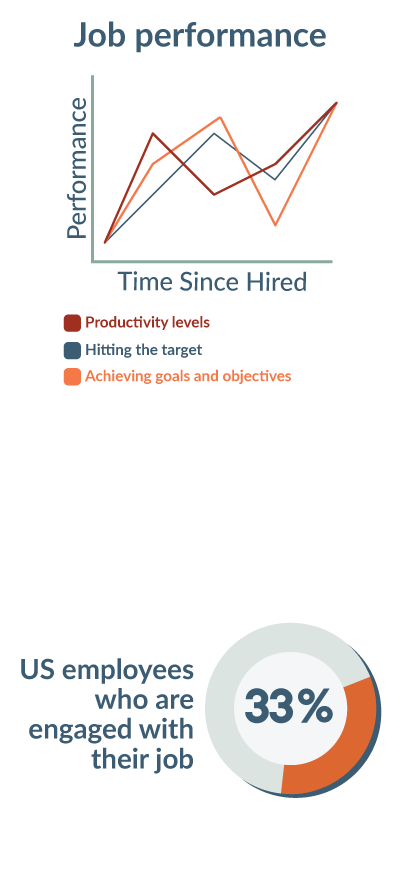The quality of hire is the process by which a company measures the effectiveness of an employee on their business overall.
Getting the right employees can make or break your company and the following statistics prove that:
- An employee who is a high performer can be almost 400% more productive than the average employee – that’s a great upside when hiring an amazing candidate.
- But on the other hand, half of the top performers aren’t really satisfied with their jobs and 20% of them are looking to leave in six months.
Add on top of this the fact that 30% of employees leave their job in the first 90 days and you get a recipe for a headache.
This is precisely why you need to focus on the quality of hire in your recruitment process.
In this article, you’ll find out how to guarantee your quality of hire, how to approach the process, and how to measure it correctly.
Understanding quality of hire
Let’s first define “quality of hire.” It’s a process by which a company values what a new employee brings to an organization. The better the impact of the new employee on the company, the better the quality of hire.
It’s about what the new employee brings to the company, in the short- and long-term. On top of measuring the candidate, it also indicates how good an organization’s recruitment process is.
If you have a good recruitment process that can find top talent, then you’ll have a better quality of hire in the end.
But it’s not just about hiring candidates you think are top performers – you also need to measure that performance to ensure you actually did hire top performers.
There are a few elements HR pros should look at when they want to establish the quality of hire:
- the company’s success and how well the employee supported their team members and co-workers, and
- metrics, such as employee performance and productivity numbers.
When you hire great candidates, they should have a positive impact on your entire company. They positively contribute to your company’s brand, status, culture and bottom line. They’ll do great at their job, excelling in their targets, and achieving their goals and objectives.
So, it’s in every company’s best interest to hire the best possible people who’ll give their best effort. That in turn will translate into more profitability for the company, higher growth rates and overall success.
But how can you pinpoint and realize which employee was responsible for specific results? How can you determine if one employee made a bigger impact than someone else? And who, in the end, is a top-performing employee?
All of these questions can be answered with clear metrics.
Approaches to measuring quality of hire
Quality isn’t quantifiable in itself. So to determine if something really is qualitative, you’ll need to have clear metrics that are measurable.
To actively measure the quality of hire, you’ll need to use pre-hiring and post-hiring metrics that’ll determine the cost-benefit ratio of each individual employee. Those metrics will help you measure the quality of hire.
Pre-hire metrics

Pre-hire metrics are used to assess the quality of hire before you’ve hired an employee. Pre-hire metrics are essential in determining not just the quality of hire, but also the effectiveness of your hiring process.
You can only get great employees if you have a great hiring process. And to ensure that happens, you need to look at the following metrics:
- Application volume. The first thing to look at is the application volume. You’ll need to have enough applications in the pipeline to pick the right candidate. It’s HRs job to work with managers to create a list of knowledge, skills and attitudes the candidate needs to become a high-performing employee. In order to find the right candidate, you’ll need to get plenty of applications. So look at the number of applications you’re getting and see if you can bring in more qualified candidates to apply for your job posting.
- Application completion rate. Once you have enough candidates filling your hiring pipeline, you’ll need to make sure all of the candidates complete their applications. Almost 90% of candidates never finish an application if it involves more than 25 questions. That’s only one way candidates can fall out of the hiring process. So look for ways to increase the number of candidates who open and complete your job application.
- Time to fill. Time to fill is an important metric that lets you know how long it takes you to fill an open spot. Time to fill measures the time needed from the moment a position opens up all the way to the point when the candidate officially accepts the position. You need to track time to fill since it shows how you can improve your hiring process so great candidates don’t exit the process early. Look for ways to shorten the process while still retaining its quality. According to a Linkedin study, it takes between 35 and 45 days to fill a position.
Post-hire metrics
Post-hire metrics are metrics you use to assess the quality of hire after you’ve hired an employee. Post-hire metrics show how candidates do in the workplace, what their impact on their colleagues is and their engagement levels.
One of the most important post-hire metrics to look at when assessing the quality of hire are:

- Job performance. Once you hire a candidate and they become your employee, you need to make sure their job performance is up to par. You hired them because you analyzed during recruitment that they might be a top performer. So now, you need to track the metrics that indicate their job performance. Productivity levels, hitting the target, and achieving goals and objectives are some of the tasks you should track to see their job performance.
- Employee engagement. Employee engagement measures the active enthusiasm the employee has toward their job. If an employee is enthusiastic about their job, they will do better at their position. Sadly, only 33% of employees in the U.S. are engaged, according to a Gallup study. To ensure you get top performers in your company, you should measure their levels of engagement at work and create an environment that stimulates engagement within your workforce.
- Employee retention. If employees are happy and satisfied at their jobs, they’re less likely to leave the company. So one of the metrics you should track is employee retention. With employee retention, you measure the stability of your workforce on a yearly basis. The bigger your retention numbers, the more employees stay at your company for a longer period of time.
Selecting the right metrics to track
There are certain metrics you should track no matter the size of your company or the industry you’re in. Metrics such as employee engagement, job performance and application volume should be tracked by most businesses since they provide a lot of benefits.
But there will be other metrics that are more specific to your industry and company size that you should take into account.
The key is to find a balance between subjective (qualitative) metrics and objective (quantitative) metrics when measuring the quality of hire. If you just measure the objective metrics, you might find yourself with an employee who is great at their job, but a nightmare to work with. On the other hand, if you’re just using subjective metrics, you might fall under bias and think some employees are top performers because of how they present themselves.
It’s important to benchmark your business across your industry and size to see how similar businesses track quality hire metrics. If you’re in the trucking business, you’re going to measure your turnover rate with other similar businesses. You won’t measure your average turnover rate, which can be as high as 90% in the trucking business, with the turnover rate of a business in the IT sector, which is around 13%.
Implementing quality-of-hire tracking system
Measuring the quality of hire is essential for business success. In order to start measuring that, you’ll need to implement a tracking system.
The first step is to ensure that you know which metrics you want to track.
The second step is to find the right technology that will make tracking those metrics easy or even automatic.
And the third step is to ensure that all the data that you get from different software technology is accurate, reliable and correct.
Measuring the quality of hire doesn’t have to be a complex operation in your business – it can be as simple as tracking a few key metrics that’ll provide you with the biggest insights.
Measure quality of hire for insights
Measuring the quality of hire is important for any business if they want to have high-performing employees. The better the employees, the better the company will do overall.
To start measuring the quality of hire, you will have to track certain pre-hire and post-hire metrics. Some will be universal, while others will be industry and size-specific.
And last but not least, you should create a clear tracking system that will help you track those key metrics.
And if you realize that you need to adapt your hiring process in order to get a better quality of hire, you should read 4 ways to up your recruiting strategies.


